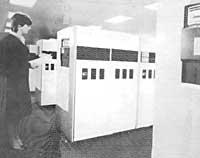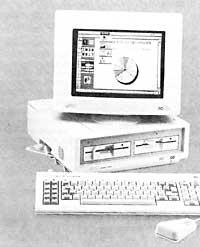Japan faced with the software crisis
1987/02/01 Lizaso, Pili - Informatika SailaElhuyar Fundazioa Iturria: Elhuyar aldizkaria
The Japanese are skilled in writing computer programs, but do not get effective in this work. Automation and a software library may solve the problems they have.
More than 25 years have passed since the first Japanese computer was released. Today, thanks mainly to advances in electronics, they can be considered faster and more reliable than those made by the Japanese computer. However, in this race to become as good as IBM in Hardware, the software has been abandoned.
Although not by people's opinion, they write good software. What happens is that they do not work effectively.

However, this situation will change. In Japan, as elsewhere, the demand for software is increasing and this means efficiency. Now, the cost of software can be 80% of the cost of a computer system. Therefore, the problem is declarable as software crisis. Japan has 400,000 programmers distributed in 900 companies. More than 70% of these programmers are dedicated to the maintenance, that is, to the adaptation and adaptation of existing software and not to the writing of new programs.
According to the International Minister of Trade and Industry of Japan, the demand for programmers is experiencing an annual increase of 26%, double the supply.
If so, the demand for specialized programmers is around 600,000 in 1990. The Minister proposes as a solution to change the line of the Japanese software industry. They must stop writing each program individually and starting from more automated software production. Last year the Minister of Trade and Industry developed the SIQMA project (five-year project) to end this problem. It will cost 70 million dollars, but will help solve the problems of the Japanese software industry.
The main drawback of the software industry is that it depends on large computers such as: Fujitsu, Hitachi and NECs. His only interest is the sale of hardware, the production of software being an inexcusable duty. In other countries, companies that run computers compatible with IBM and IBM dominate the market. The leadership of these companies has been efficiency in making software packages to independent software companies.
These packages are sets of programs aimed at the needs of a user group and can run on all supported computers. In Japan, in addition to IBM, there are another dozen computers that exercise strong competition. As a result, they have several different types of computers. In addition, written software for one type of computer is not valid for another type of computer, and this is not economically profitable.
40% and 60% of software in Europe and the USA respectively are sold in packs that each user adapts to their system. In Japan, however, the software sold in packages is only 10%, most of them imported for use on computers compatible with IBM.
Most Japanese software houses are associated with a special hardware manufacturer, that is, as computer support, they have been built to provide software to their machines. In the US, however, it does not happen.
In the din they have taken to sell the hardware, Japanese authors have given software for free. This is a bad habit that makes customers in Japan not want to pay for the software.
Companies that sell hardware offer a group of programmers to write the programs their customers need. These programmers get them by outsourcing.
Custom-made software for customers should be, in theory, better than a software package (oriented to the specific needs of customers), but in reality it also has its drawbacks to write such software. Programmers do not cover the time needed for designs and tests, and in many cases the programs they put into service are incomprehensible and difficult to maintain.
On the other hand, there is not much motivation to make better products.
In Japan, being a programmer is not a very attractive profession: they have a low salary, they include an average of 45 overtime a month and today and tomorrow they have to walk here. Under these conditions it is not surprising that the most persevering student prefers to devote himself to the hardware world.
In addition, the retirement age of Japanese programmers is 35 years. This has been an obstacle to the development of large systems, work that requires many years of experience.
The problems of the Japanese software industry cannot last long. Hardware authors have seen that they can no longer offer free software to their customers. Software development costs have increased considerably and hardware prices have declined disproportionately. Therefore, authors cannot continue to sell only hardware.
At the moment, Japanese computers are not able to develop software. However, ways are being opened to overcome their software shortcomings. They have seen that at least they have to start writing software packages instead of software related to the direct needs of customers. To do this, customers should be encouraged to use the standar operating system.
On personal computers CPM and MS-DOS operating systems have also been imposed in Japan. The authors provide extensive information about their systems so that independent software companies can write programs for their machines.
This step is important because the more software you are able to run, the more useful the computers are.
On the other hand, 20 years ago, engineers at ATT Bell Laboratory built the UNIX system. This system has attractive features: on the one hand, a group of users can use the computer resources at the same time. On the other hand, they can also take data from a file. In addition, the UNIX system is not very expensive.
The other advantage of UNIX lies in its history. It was built at the universities of California and Berkeley, where students wrote programs called tools. These programs facilitate the construction of other programs.
Currently the UNIX system is well known in Japan. With the entry into Goimail universities 10 years ago, the UNIX system has become one of the best-known agents. The SIGMA project is based on UNIX and seems to drive it towards standarization.
At first the UNIX system needed a large computer to run programs written in high-level programming language, which could be an impediment. However, the company NEC launched the 9800, a 16-bit personal computer, fast and suitable for developing software. This personal computer is revolutionizing the Japanese software industry.
Through these advances the productivity of programmers increases and software specialists claim that Japanese programs will be increasingly sophisticated.
Most of the software previously developed for personal computers was aimed at games. Now, on the contrary, they are used for the treatment of texts and library packages.
Therefore, in a fully divided market, we have a known operating system equipped with tools, library and executable machine.
UNIX has become the main Japanese operating system, but will not solve all software problems, such as for large corporations, such as banking, is not fast enough.
The UNIX utility is generating a new problem. Forgotten by hardware authors, the UNIX system is adapting to its own computers rather than following the path started earlier.
If the Japanese have to overcome the software crisis, they will have to learn to live their way.

Gai honi buruzko eduki gehiago
Elhuyarrek garatutako teknologia





